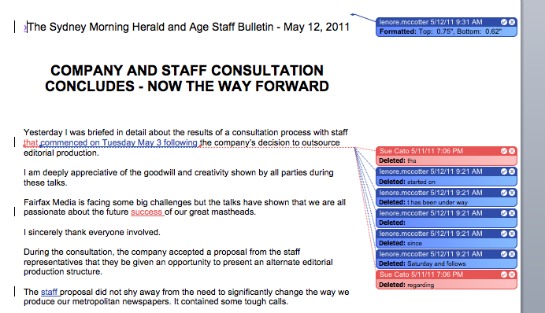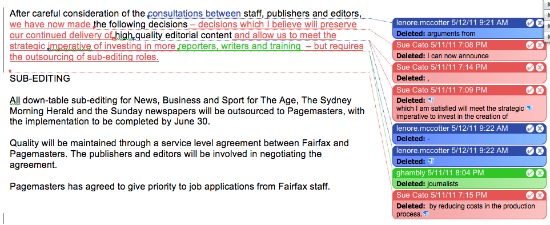What could be more embarrassing to a reporter than the incident from a couple of months ago when The Washington Post accidentally published a first draft of a writer’s story online with the editor’s notes included?
A May 12 memo sent from new-ish CEO Greg Hywood to staff of Australian company Fairfax Media’s two big broadsheets—The Sydney Morning Herald and The Age—turned out to also be in draft stage, with “Track Changes” on and alterations in the text plainly visible.
This would be fine if all Hywood was doing was wishing staffers a happy Easter. But Fairfax has been embroiled in battle with workers’ union The Media Entertainment and Arts Alliance over a decision announced earlier this month to fire subeditors in its metropolitan news rooms and outsource the work—a hybrid of copy-editing and fact-checking in most cases in Australia—to Pagemasters, a subsidiary of the Australian Associated Press (AAP). The Australian reports eighty-two jobs are going. Hywood’s draft memo was a confirmation that the company would be going ahead with the firings after rejecting an alternative staff plan submitted as part of negotiations taking place since the initial announcement. Worse: the track changes showed that Sydney-based PR big-shot Sue Cato had massaged the memo to make it more palatable to a galvanized Fairfax staff.
Here’s what it looks like:

And a close look at a key paragraph.

By going through and rejecting the track changes you can see the differences between the language in the draft and the edited versions. Here’s one of Hywood’s original paragraphs:
After careful consideration of the arguments from staff, publishers and editors, I can now announce the following decisions, which I am satisfied will meet the strategic imperative to invest in the creation of high-quality editorial content by reducing costs in the production process.
And here’s the graf after Cato and two others made changes.
After careful consideration of the consultations between staff, publishers and editors, we have now made the following decisions – decisions which I believe will preserve our continued delivery of high quality editorial content and allow us to meet the strategic imperative of investing in more reporters, writers and training – but requires the outsourcing of sub-editing roles.
So, “arguments” become “consultations,” “I” becomes “we,” investing in “high-quality editorial content” becomes investing in actual people, there is less “announcing,” and no blunt talk of “reducing costs.”
For full disclosure, it should be noted that I worked for Fairfax Media in Sydney from 2007-09, was a member of the Alliance, and, like most of the staff, participated in meetings and one small demonstration amid rounds of redundancies at that time, which will no doubt ring familiar to American readers.
It should also be noted, in fairness, that Fairfax has been in a precarious financial position for years and that dramatic structural changes were arguably as necessary as they were inevitable. And that Hywood, while a tough talker, has also proven in his short time as CEO—he was instated in February—one of the few Aussie media heads to take an aggressively forward-looking approach. At Fairfax, he is, at least so far in what he has been saying, putting an unprecedented emphasis on improving the quality of the group’s journalism, making inroads into digital content production, and, in the parlance of this country’s politics, seems dedicated to “winning the future” in a way few of this company’s past CEOs have. And the announcement—in this very leaked memo—that he will be installing public editors, a rarity in the Australian press, is encouraging.
But, as that same memo shows, Hywood, like the rest of us, still needs a good subeditor.
Joel Meares is a former CJR assistant editor.
